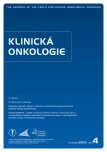IKARUS Project – Incidence of Bone Events in Breast Cancer: Retrospective Analysis of Patients in Oncological Centres in the Czech Republic and Slovakia
Authors:
J. Fínek 1; J. Prausová 2; V. Čmejlová 2; K. Cwiertka 3; H. Švébišová 3; R. Vyzula 4; M. Holánek; M. Bodorová 5; L. Slavíček 6; M. Kubecová 7; L. Loukotková 7; R. Neumanová 8; K. Lepeyová 9; M. Lysý 10; J. Šmejkal 10; R. Soumarová 11; J. Ryšková 11; K. Kališová 1; J. Machanová 12; M. Bohušová 13; V. Alakša 14; M. Streško 15; T. Šamanová 1; M. Kůta 16; J. Vaňásek 17; K. Vondráčková 17; M. Vargovčíková 18; J. Petera 19; E. Pritzova 20; O. Bednařík 21; A. Hlaváčová 21; I. Jančoková 22; O. Szeghöová 23; A. Dammak 24; J. Lešková 25; K. Chroust 26; L. Dušek 26
Authors‘ workplace:
Radioterapeutické a onkologické oddělení, FN Plzeň 2Radioterapeuticko onkologické oddělení, FN Praha Motol 3Onkologická klinika, FN Olomouc 4Klinika komplexní onkologické péče, MOÚ Brno 5Onkologicko rádioterapeutické oddelenie, Ústredná vojenská nemocnica
1
Published in:
Klin Onkol 2009; 22(4): 154-162
Category:
Original Articles
Overview
Backgrounds:
Bone incidents today represent, in terms of frequency and the overall effect on the quality of life of patients with breast cancer, a serious health problem. In a number of clinical studies bisphosphonates have been shown to have a positive impact on reducing the risk of bone events and therefore to be effective in the prevention of bone events. The primary objective of this project was to identify the incidence of bone events in patients with metastatic breast cancer treated in the Czech and Slovak Republics. Subjects: Retrospective, multi centre, non interventional, epidemiological and explorative studies to identify the incidence of bone events in the defined group of patients and a description of the practice of prevention and treatment of skeletal events in the years 2000–2005. Enrolled were patients with advanced metastatic breast cancer diagnosed in 2000. Methods and Results: Analysis of overall survival and survival to disease progression, analysis of patterns of treatment of bone events and the practice of the use of bisphosphonates in the prevention of bone events in metastatic skeleton affection in the normal conditions of clinical practice, analysis of patient compliance in the treatment with bisphosphonates, analysis of the time interval between the occurrence of bone metastases and the occurrence of bone events and, last but not least, survival analysis of patients in relation to bone events. Conclusion: This work has shown that the practice of treatment with bisphosphonates since 2000 and assessed the survival of patients with metastatic breast cancer.
Key words:
breast cancer – bone event – bisphosphonate – survival – retrospective study
Sources
1. ÚZIS (Ústav zdravotnických informací a statistiky), Česká republika.
2. Coleman ER. Bisphosphonates in breast cancer. Ann Oncol 2005; 16 : 687–695.
3. Lipton A, Theriault RL, Hortobagyi GN et al. Pamidronate prevents skeletal complications and is effective palliative treatment in women with breast carcinoma and osteolytic bone metastases: long term follow up of two randomized, placebo controlled trials. Cancer 2000; 88 : 1082–1090.
4. Coleman RE. Metastatic bone disease: clinical features, patophysiology and treatment strategies. Cancer Treat Rev 2001; 27 : 165–176.
5. Diel IJ, Body JJ, Lichinitser MR et al. MF 4265 Study Group. Improved quality of life after long – term treatment with biosphosphonate inbandronate in patiens with metastatic bone disease due to breast cancer. Eur J Cancerm 2004; 40 : 1704–1712.
6. Pour L, Hájek R, Adam Z. Výběr bisfosfonátu k léčbě maligního postižení u pacientů s prokázanou malignitou. Klin Onkol 2005; 18 : 172–177.
7. Fleisch H. Development of bisphosphonates. Breast Cancer Res 2002; 4 : 30–34.
8. Chroust K, Fínek J, Zemánek P et al. Zkušenosti s managementem dat retrospektivního klinického projektu v podmínkách české a slovenské onkologie (projekt IKARUS). V tisku.
9. Vokatá V, Odrážka K, Kuběna A et al. Retrospektivní analýza klinické praxe léčby metastatického postižení skeletu pacientek s karcinomem prsu dispenzarizovaných ve dvou centrech ČR. Klin Farmakol Farm 2006; 3 : 129–134.
Labels
Paediatric clinical oncology Surgery Clinical oncologyArticle was published in
Clinical Oncology

2009 Issue 4
- Possibilities of Using Metamizole in the Treatment of Acute Primary Headaches
- Metamizole vs. Tramadol in Postoperative Analgesia
- Metamizole at a Glance and in Practice – Effective Non-Opioid Analgesic for All Ages
- Safety and Tolerance of Metamizole in Postoperative Analgesia in Children
- Metamizole in perioperative treatment in children under 14 years – results of a questionnaire survey from practice
Most read in this issue
- Primary Pulmonary Sarcomas
- Palliative and Hospic Care in the Czech Republic and in Europe
- Radical Surgery and Intensive Chemotherapy Are Necessaryfor Successful Treatment of Osteosarcoma
- Treatment with Sunitinib and Hypothyroidism – a Case Report and Overview of Literature
